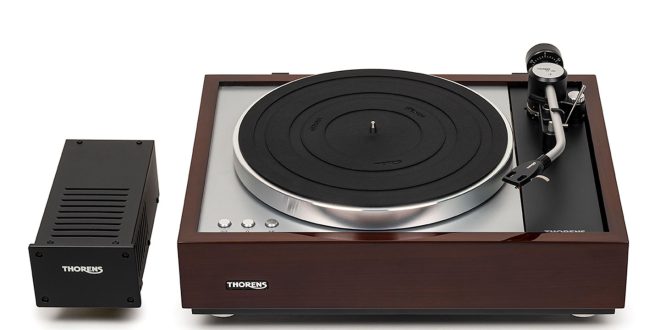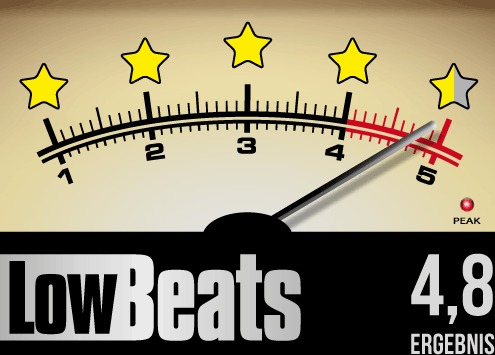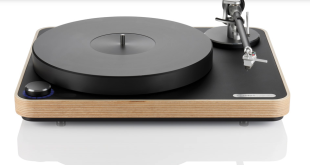The TD 1600 is perhaps the most irresistible of all the new Thorens players – both aesthetically and technically: the proportions are perfect, the sub-chassis works superbly. But together with the new tonearm, i.e. the Thorens TD 1600 with TP 160, the combination comes within reach of a quality that has often become unaffordable elsewhere.
Walnut or black? Automatic or manual? You do have to make a few decisions when ordering the Thorens TD 1600. The TD 1601 player is also available with an electronically controlled servo lift and automatic limit stop. This costs an extra 500 euros. 500 euros, which 70 out of 100 buyers are apparently more than willing to pay. An interesting figure, which is now also based on significant quantities, as the 1600/1601 has been around for a while.
So the “big” Subchassis-Thorens is not mainly bought by hardcore analog fans, who are back at the player after two tracks anyway to tweak something. Especially as all the adjustment options are also available to the comfort customer: The arm height adjustment, for example, which used to fall victim to the automatic system, remains fully usable on the 1601. And since the limit switch can be switched off, nothing stands in the way of extensive enjoyment of endless grooves. After all, everyone should have the chance to try Godspeed You! Black Emperor’s “f# a# ∞” as it is intended and already hinted at in the album title with the infinity sign. After a few turns, you can switch off manually. Unless, like the author in 1997, you have sunk into a kind of trance and only realize after half an hour that a – fairly obvious – endless loop has been running the whole time.
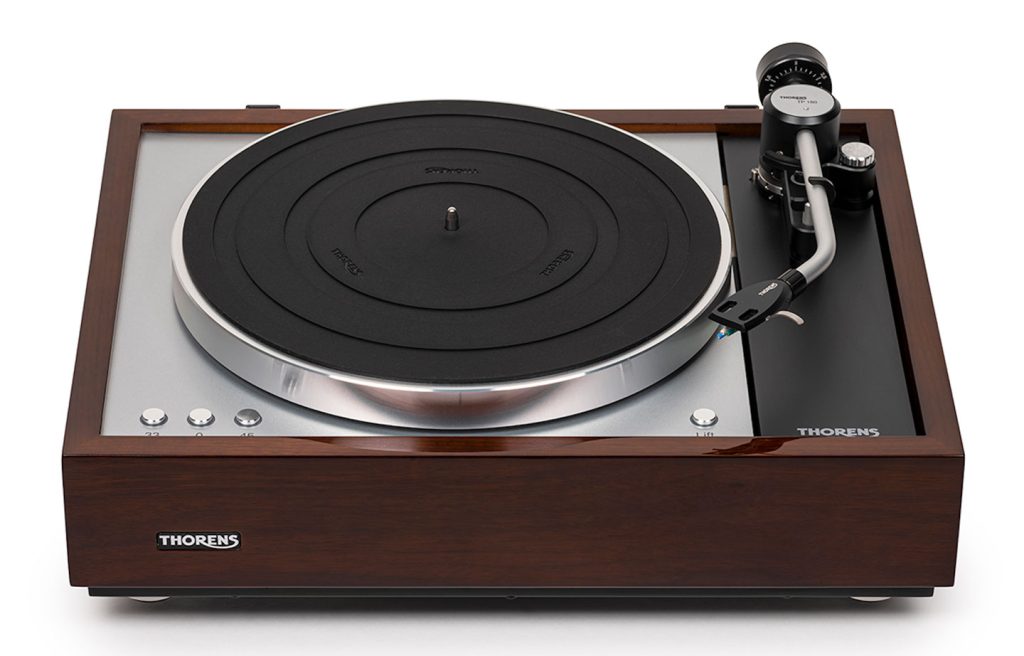
Visually, the Thorens is the archetype of a high-quality turntable. You can’t get much more classic than this: sturdy, thick-walled wooden frame, aluminum top deck, the laminated tonearm board set off in black on the right with the circumferential joint that makes it clear that the arm and platter bearing live on their own chassis, separate from the frame. A flick against the armboard or platter immediately reveals the nature of the connection between the sub-chassis and the frame: the former gives way softly and elastically and slowly comes to rest again, swinging out.
The sub-chassis rests on three conical springs made of steel wire, whose spring constant together with the mass of the platter, arm and sub-chassis support results in a resonant frequency of approximately 2 Hertz. A few hertz above that at the latest, the spring suspension no longer transmits any energy. The synchronous motor could therefore vibrate happily: As it is not part of the sub-chassis but mounted on the frame, its vibrations do not find their way to the sensitive parts of the player. The only potential sneak path is the drive belt, but even this is elastic and does not transmit very well at the typical interference frequencies.
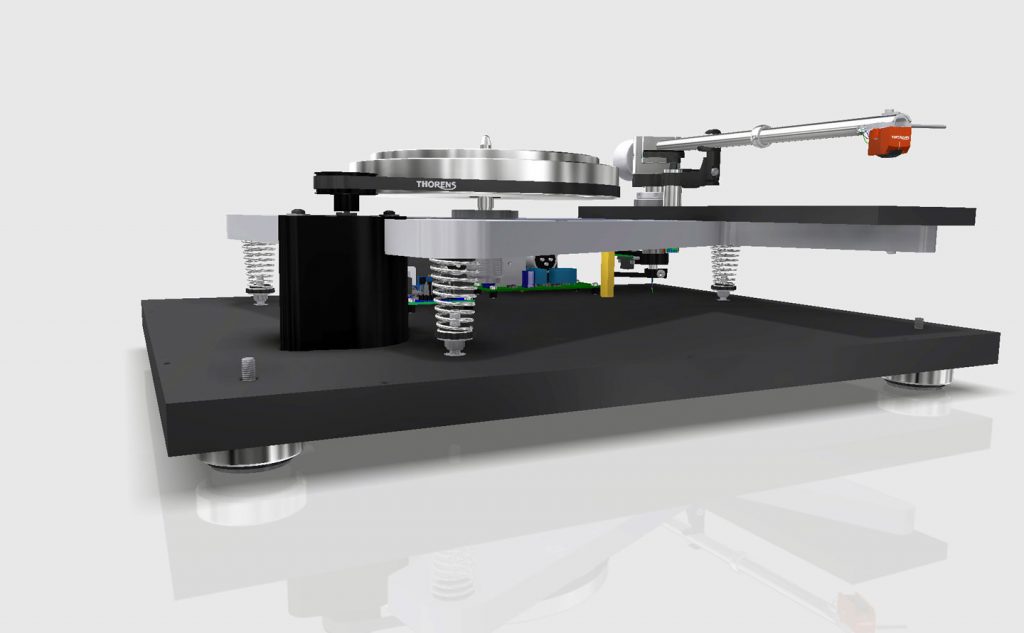
Historically, this has always been the main task of a sub-chassis: To make the engine disappear as the main source of vibration. Early Thorens and Linn models, for example, achieved fantastic signal-to-noise ratios despite their rustic, directly mains frequency-controlled motors. Like current larger Linns, today’s Thorens has a two-pronged approach: On the one hand, it makes use of the almost perfect decoupling of a free-swinging sub-chassis. On the other hand, it electronically ensures that the engine runs smoothly and silently from the outset. For this purpose, the motor receives synthetically generated alternating voltages, the amplitude and phase position of which are precisely adapted to the specific unit. Thorens did not buy an off-the-shelf solution for the technical implementation of this motor control, but commissioned the German development veteran Walter Fuchs to do it. The true electronic grip of the 1600/1601 is therefore hidden deep in the frame. The imposing separate transformer housing, connected to the player by a lockable cable, only supplies the circuit with the necessary power.
The platter has a classic two-piece design and is made of shimmering, uncompromisingly precise turned aluminum. The inner platter has a diameter of 16 centimetres with an approx. 1 cm wide step at the edge, on which the outer plate ring then rests. Ringing vividly on their own, the two halves of the plate calm down instantly and completely as soon as their contact surfaces meet during assembly. Very similar to the legendary Thorens ancestor TD 160 – or the Linn LP12.
But also different again: Thorens today turns both platter parts from aluminum, while Linn, as always – and as Thorens once did – first casts them from the zinc alloy Zamak and then brings them into their final shape on the lathe. Zamak is more than twice as dense as aluminum, which is why the outer plate of my LP12, for example, is a full pound heavier than that of the 1600 despite its thinner walls. On the other hand, the fit of the 1600 is actually a touch more precise.
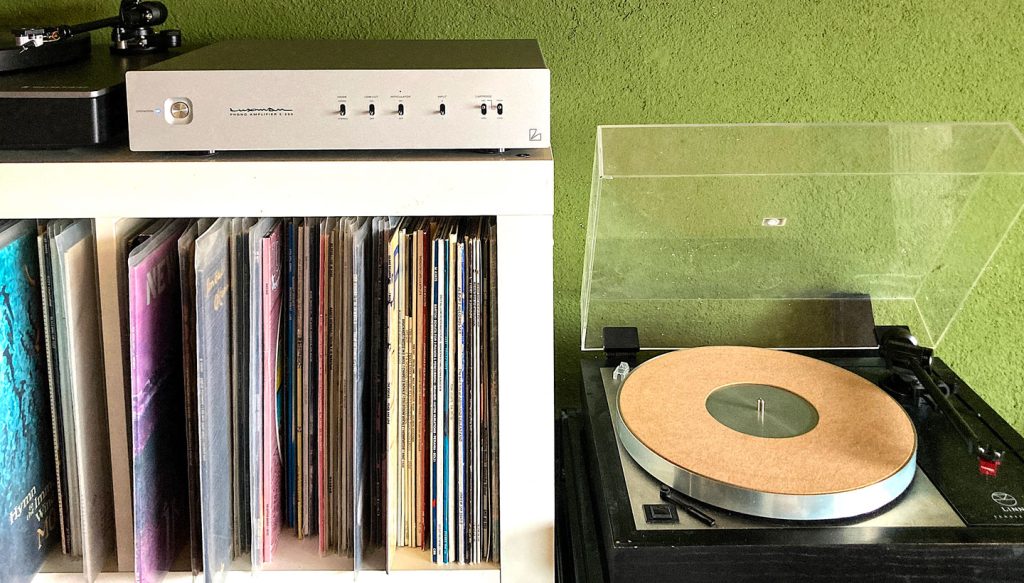
The brief sideways glance at LP12 is no coincidence, or just because the player is standing here with me. But because the models, with their classic lines and sub-chassis construction, fall into the same audiophile category and are also quite close in price in terms of basic equipment. The “Majik” package contains the MM cartridge Adikt, the tonearm Krane (manufactured by Clearaudio) and the very small motor control, which consists of a passive circuit board without speed switching. Theoretically, you can also hear 45s by pressing an aluminum adapter with a larger diameter onto the pulley and then putting the belt back on. But I’ve never seen anyone do that. From a practical point of view, the basic LP12 is a single-speed fixie until you take pity on it and treat it to the external Lingo power supply. For around 2,000 euros extra. Only this is then comparable in its capabilities and functionality to Walter Fuchsens control boards and power house, which the Thorens 1600 comes with as standard. The situation is similar with the pickup: The Linn Adikt is a (very good) MM with a gold ring heart. But for 4400 euros, the complete price of the Majik LP12, we can easily get the Thorens with the in-house MC TAS 1500. And that is simply even better than the adict.
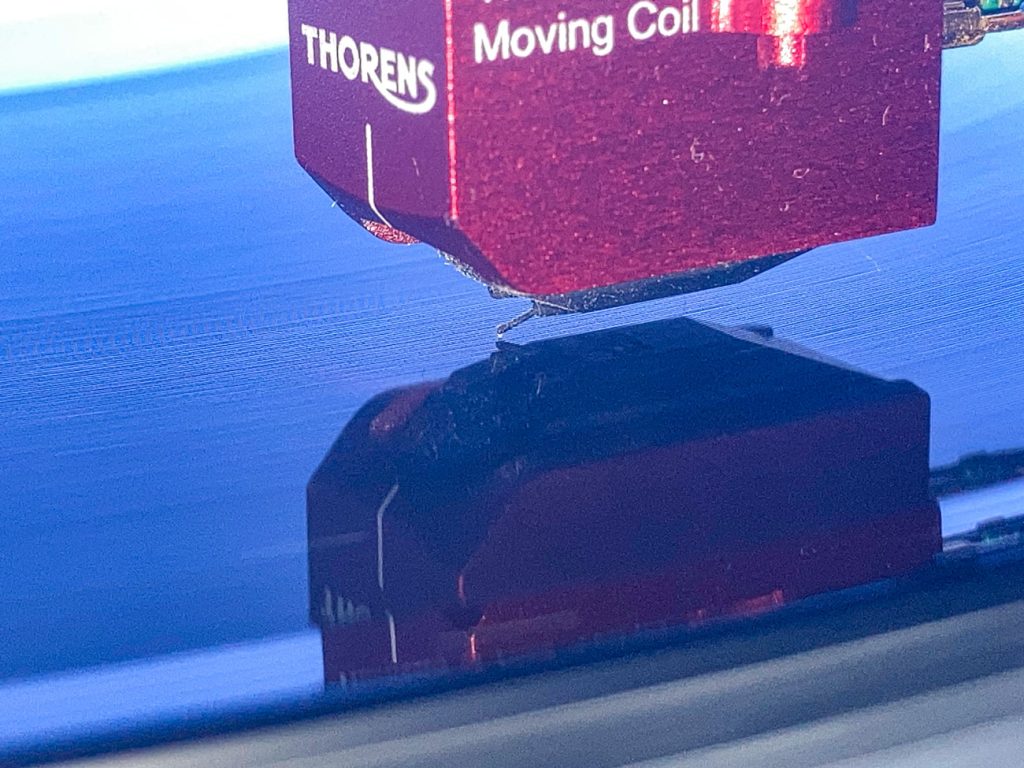
The 1500 is built by Audio-Technica. The origin is not as easy to recognize as with the small Linn-MC Koil, also produced by AT. This is due to the aluminum housing that Thorens designer Helmut Thiele tailored for the TAS models – while Linn simply adopted the body of the AT-OC series. Technically, there are clear parallels: Both OEM ATs feature a super-rigid boron needle carrier and the MicroLine diamond, whose almost obsessive attention to detail appeals to many, but not all music fans. In fact, the TAS 1600 is not only the better choice for the TD 1600 in terms of name, but also in terms of sound. It costs 400 euros more and boasts Audio-Technica’s best diamond, the “Special Line Contact”.
The big step: Thorens TD 1600 with TP 160
The TAS 1600 plays so naturally and harmoniously with undiminished attention to detail that the decision is a classic no-brainer. Especially as we are then still at an extremely competitive total price of 4,700 euros. It’s not cheap fun, but it’s lasting fun, and it’s already well developed in every detail. In addition to the good motor control, the Thorens also has an outstanding tonearm ex works. We are not referring to the TP 92 with which the 1600 was originally launched. But the new TP 160, which shouts “delicious!” with every one of its nine inches of effective length. Designer Helmut Thiele has designed the TP 160 as a modern-day version of the legendary EMT professional arm 929. And, for my taste at least, hit the bull’s eye.
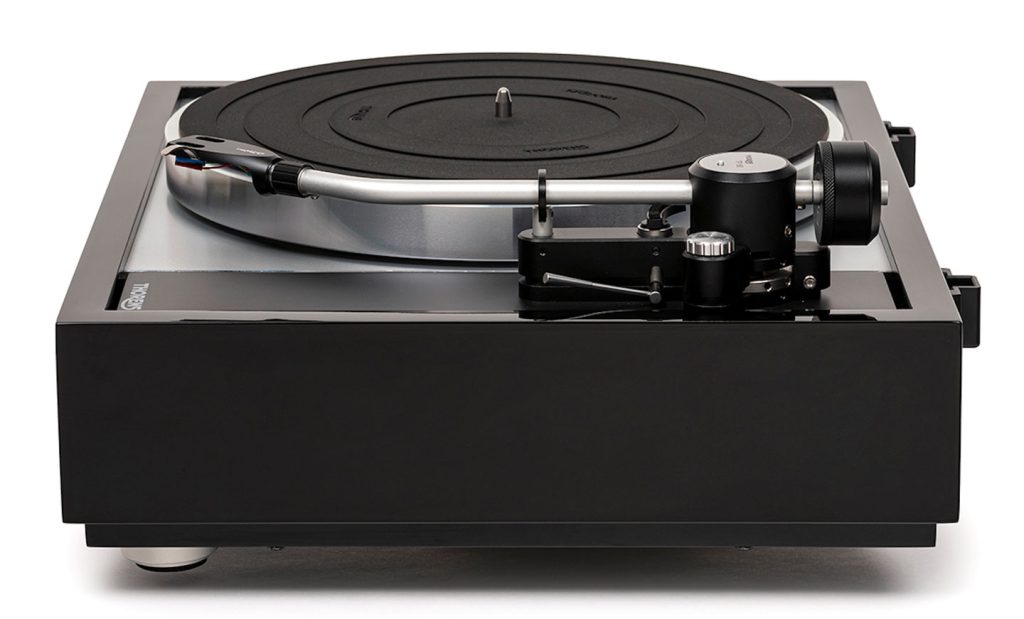
This matte silver and matte black clay tool with its large caliber J-shaped bent barrel and iconic large stock cylinder instantly instills confidence. And then pays back this advance in practical use and in the hearing test with the most lavish interest rate. Stable, rigid, extremely smooth-running and comprehensively adjustable, it makes analog researchers who like to experiment and pure music connoisseurs equally happy. And behind its understated exterior, it also has something for mechanics nerds to talk about. Namely, a new bearing for vertical movement that follows the principle of the blade bearing. The arm thus balances like a seesaw on a sharp blade made of hardened steel, which stands in a likewise hardened bowl with a slightly wider opening angle.
Helmut Thiele has eliminated two weak points in his design that bothered him in previous cutting bearings. Firstly, the bottom of the bearing shell is not rounded in any way, but consists of two halves that meet in an exact line. Secondly, the Thorens bearing can neither slide back and forth sideways in its seat nor tilt upwards out of it. This is prevented by small but powerful neodymium magnets that keep the blade and bowl perfectly centered at all times. The rotation of the arm over the plate, on the other hand, takes place quite conventionally in ball bearings, albeit of the finest Japanese provenance.
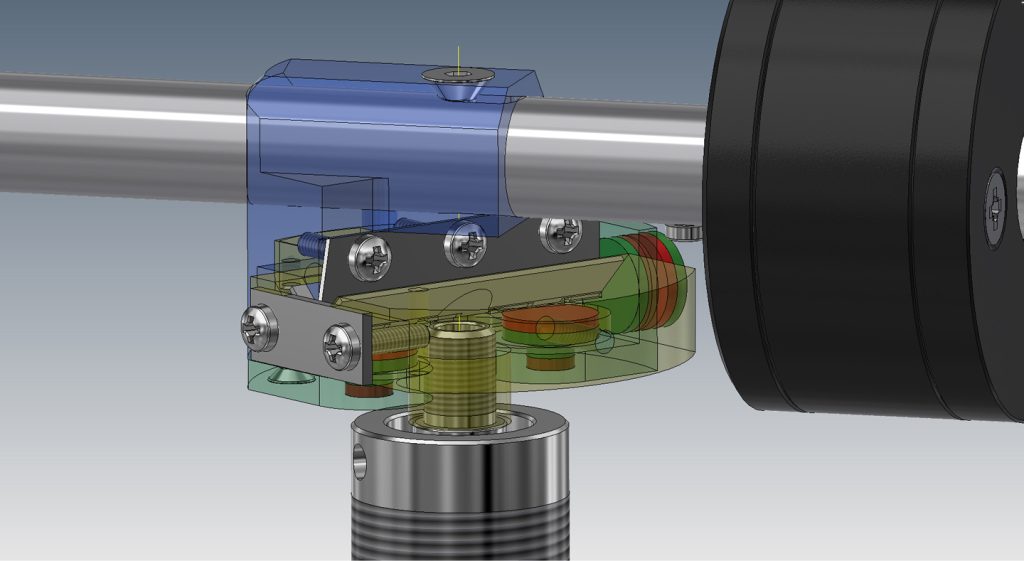
The TP 160 also comes with a newly designed headshell with a classic SME coupling. You can therefore fit any third-party shells or an SPU sound box to the front of the arm instead. The arm tube can even be adjusted axially so that the overhang is exactly right even with such headshell-less, non-adjustable systems. The ease of installation and replacement inevitably comes at the cost of some stiffness, because removable headshells of this design never actually sit one hundred percent free of play. However, the standard Thorens head performs significantly better in this respect than the Technics parts, for example. The headshell has a small clamping screw that allows the azimuth to be corrected after opening with a 1.5 mm Allen key. This is quite fiddly, but fortunately you rarely have to do it: with well-made pickups, the azimuth should be correct if the system is exactly parallel to the record. Especially as a needle that is not vertical can be straightened by turning the system, but then the rest of the generator will be askew. So you slip from the rain straight into hi-fi purgatory.
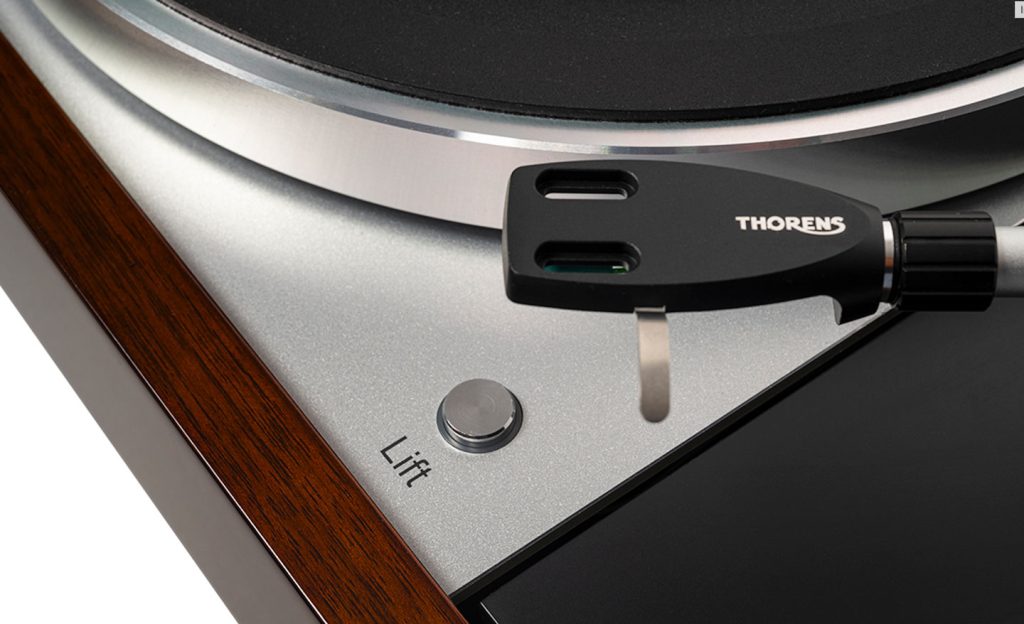
We simply aligned the Thorens system parallel to the platter in all axes. With the VTA, aka tonearm height, this is exemplary easy: first loosen the small locking screw on the arm base, then screw it up or down with the large perforated ring nut, whereby one full turn corresponds to exactly one millimeter. As a turning aid, Thorens includes an aluminum pin that fits into the hole in the side of the nut. But it’s just as easy without.
Another exemplary feature is the magnetic anti-skating system with a classically scaled adjusting wheel, which can also be carefully turned during operation. The two 1600 models differ in terms of the lift: the 1601 raises and lowers the arm at the touch of a button using a miniature servo and a small gearbox. Where this fits, the 1600 has the tried and tested manual lift with silicone damping. The great popularity of the servo model is certainly also due to the somewhat unsteady nature of all real sub-chassis: the manual lift has to be operated carefully because it is located on the moving part of the player. The metal lift button of the 1601, on the other hand, sits perfectly decoupled on the front of the frame. If necessary, they could also be operated with a rubber mallet without the playback level noticing anything.
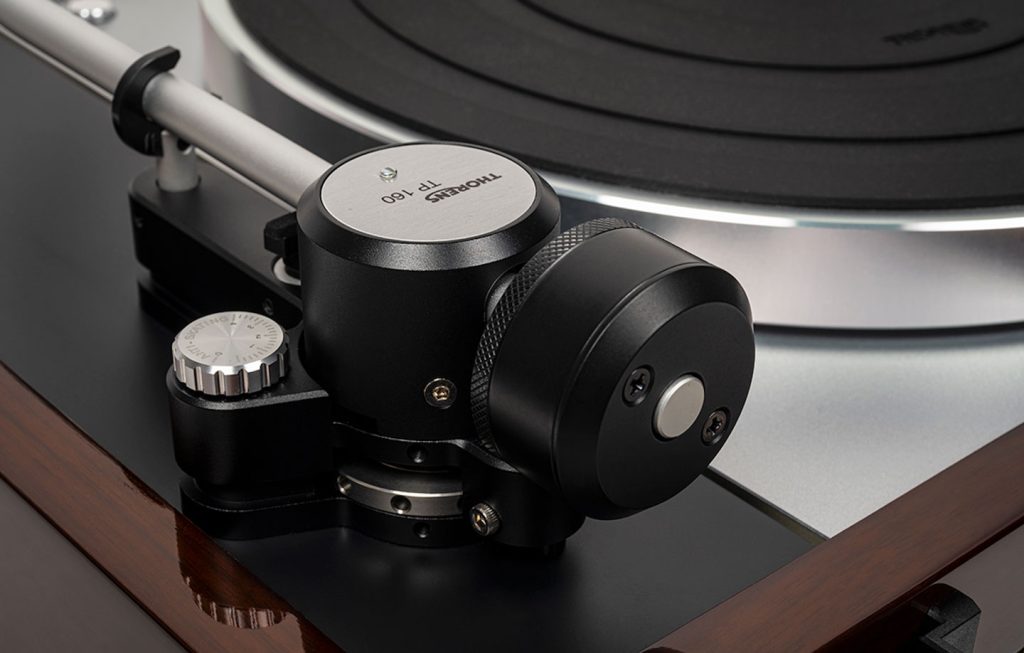
The typical sub-chassis rocking of the 1600 is remarkably harmonious and wobble-free. And without any special spring adjustment ritual, as required by a new Linn during the initial setup. Thorens has basically retained the traditional three-spring sub-chassis, but has added a few very effective modifications. This includes a ballast weight that centers the center of gravity of the sub-chassis symmetrically between the springs. Likewise the new engine position on the front left instead of the rear left of the frame. Above all, however, a thin steel cable directly opposite the motor counteracts the belt tension and thus ensures a balance of the forces acting on the sub-chassis.
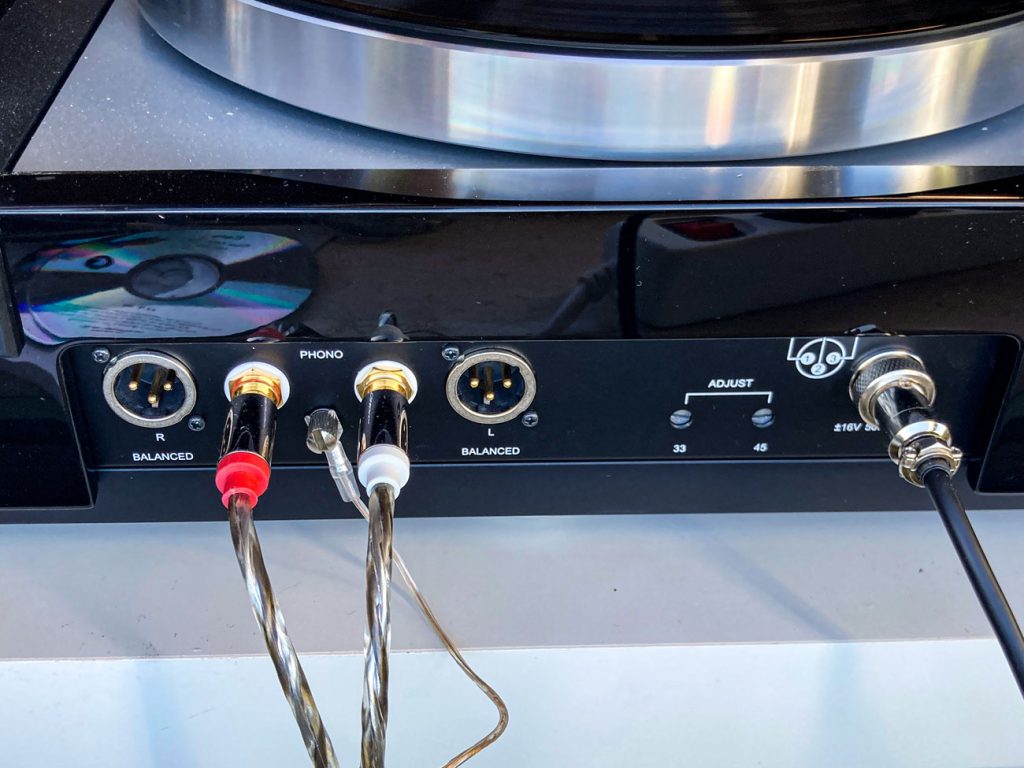
Hearing test
In combination with the upright (instead of traditionally suspended) springs on this player, the result is an absolutely well-behaved, predictable vibration behavior that did not change one iota during the month-long guest performance in my listening room. Should the steel springs settle slightly at some point, they can be readjusted on the base plate without having to open the player.
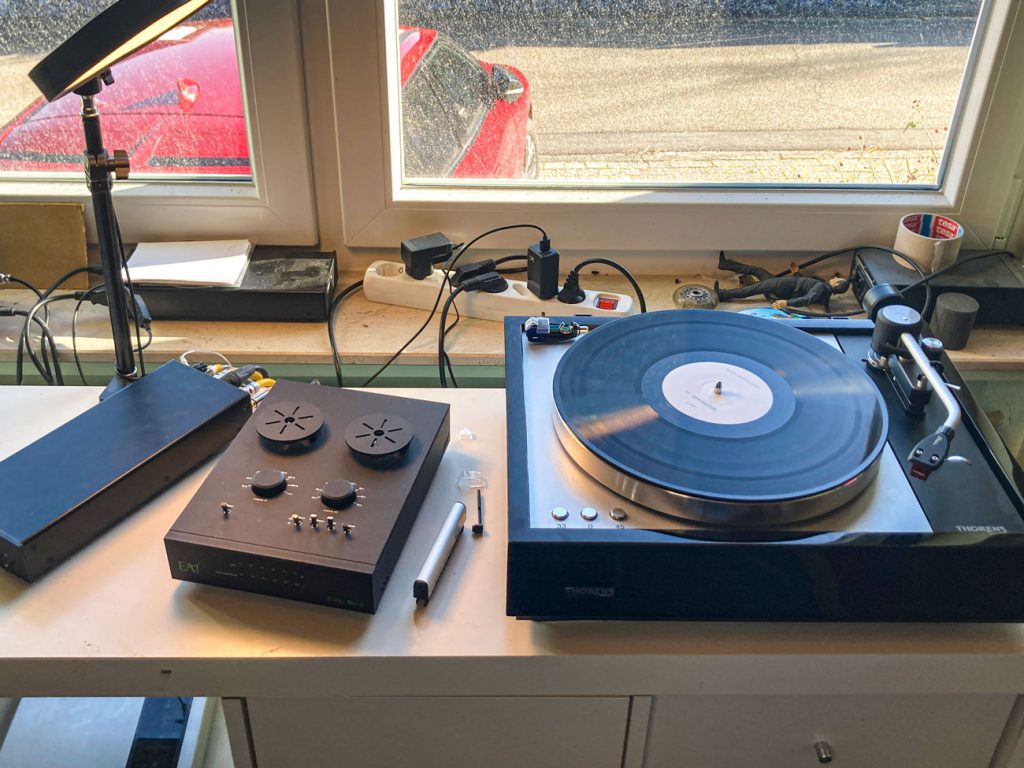
In the listening room, the Thorens presents itself as a practically perfect record player. The scanning with the TAS 1600 is so unshakeable that you stop secretly sorting your record collection according to more or less “well-pressed” copies and then tend to play only the good ones. Highly compressed and otherwise bad records do not cease to exist: “Amber” by the band Clearlake (Domino – WIGLP152), for example, was released in 2006, at the historic peak of the Loudness War, and actually sounds awful. Even the best record player won’t help. Instead, Mice Parade’s “Obrigado Saudade” from 2003 (FatCat Records – fatlp29) jumps into the listening room with astonishing dynamics. Acoustic guitars, percussion and Kristín Anna Valtýsdóttir’s dreamy vocals in the first track “Two, Three, Fall” seem almost three-dimensionally vivid, fresh and colorful. And in the long “Mystery Brethren” that follows, it is a pure pleasure to listen to – almost watch – ever new layers of instruments as they interweave with the existing ones. And this lively, colorful fabric of sound simply does not become confusing, but spreads out effortlessly and clearly in front of the speakers. In this case, by the way, a pair of Klipsch Heresy IVs, which develop an unexpectedly audiophile sensitivity on the new, outstanding Cayin Jazz 80 integrated amplifier.
I’ve had the record for 20 years. It also shows that long playing times do not necessarily mean a flat sound: Mastering engineer Mandy Parnell has included 29:34 minutes on the A-side alone. In 2003 there wasn’t yet a vinyl boom, so labels thought three times about whether they should risk an expensive double album. The record still sounds fantastic, but it’s not easy to listen to because Parnell has really pushed the record radius to the limit. For the last tracks on each side, the groove is very tight, with only half the circumference of the first track. The “Special Line Contact” diamond of the TAS 1600 is admirably indifferent to this: the music is neither muffled nor impure, nor do the dynamics suffer.
Dynamics in general: The Thorens may look classic and somewhat stolid, but it is a very tight and impulsive sounding turntable with lively, agile timing. Like its technical relative from Linn, it brings bass lines and drum rhythms to full, energetic life. It does this even better than the first-generation 1600, which still had a TP 92 instead of the TP 160. The arm upgrade has made the player more expensive, but also understandably better and more balanced (and, in my opinion, much prettier). It is therefore gratifying that Thorens offers an upgrade that includes the arm swap and the necessary modifications to the sub-chassis. This means that owners of the first 1600 generation can also enjoy the new arm – albeit not cheaply.
Is it worth it? Absolutely! Especially if you want to run MCs with the player, the TP 160 is clearly superior. In much the same way that the Linn Ekos is superior to the Akito from the same company – only at a much friendlier price. The TP 160 offers the stability and quietness that top MCs need, it provides the mass and strength to deal with the mechanical forces that the usually rather stiff MC generators introduce into the headshell. This point could be further enhanced with a fixed headshell. But I am happy to make this small compromise. Because such an interchangeable headshell is simply much more convenient and versatile in practice. Especially for record listeners who like to experiment and try out a different pickup. And because you really don’t find much of this compromise in the sound: I have heard the Thorens MC not only in the TP 160, but also in the Linn Ekos 1 on my LP12. It also sounds fantastic and not at all dissimilar, at any rate not significantly more dynamic.
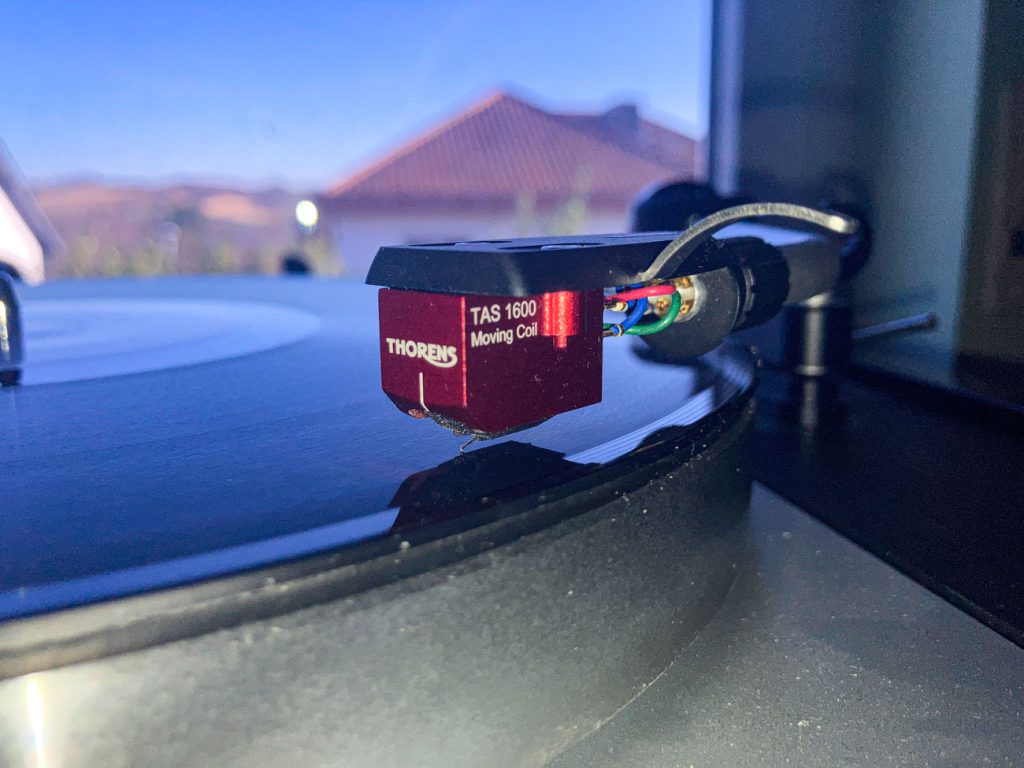
The TAS 1600 may have Audio-Technica genes, but it sounds better in the Thorens arm than the AT original AT-OC9XSL, on which it is obviously based according to the data sheet: more tuneful, even more powerful. Perhaps the Thorens-specific housing with its slightly higher mass is responsible for this. HiHat cymbals really sound like metal, with finely traced opening and closing and a fascinating, bronze-shimmering fine structure. However, the voices are not too woodcut-like, but with a real, weighty body and expressive phrasing. Bass lines march springily and muscularly and ensure a perfectly harmonious overall balance. Anyone who is afraid of thin-lipped, lisping singers and has therefore perhaps avoided MCs until now: It probably wasn’t just the MC’s fault, but also an overworked arm and a stiff-hip drive. Even under such conditions, MCs often still deliver sharp outlines, but no longer fill them with color, life and substance. That’s what makes really good drives and arms. The 1600 is a really good drive. Even an outstanding one. And even if I find that difficult with a 4000-euro device, I’m toying with the idea of calling it “inexpensive”. Simply because I can’t really think of an equivalent turner at this price.
Conclusion Thorens TD 1600 with TP 160
The new TP 160 tonearm has made the TD 1600 more expensive. On the other hand, an arm of this quality with a different name, smaller quantities and perhaps a dash of esotericism would be worth the price of the complete player all by itself. In this respect, the TD 1600 with TP 160 is an unquestionably luxurious, but fair offer.
Rating
Sound QualityUsabilityBuild QualitySummary |
| The rating always refers to the respective price category. |
| | Wonderfully clear, dynamic sound |
| | Universal, easily adjustable tonearm |
| | Connection panel with XLR and RCA sockets |
| | Maintenance-free and cleanly vibrating sub-chassis |
Distribution:
Thorens Ltd.
Lustheide 85
51427 Bergisch Gladbach
www.thorens.com
Pair price (manufacturer’s recommendation):
Thorens TD 1600 with TP 160: 3,500 euros
The technical data
| Thorens TD 1600 / TP 160 | |
|---|---|
| Concept: | Belt-driven record player with 33/45 rpm |
| Tone arm: | TP 160 with SME headshell, effective mass: 14 grams |
| Turntable: | 12″ / 4.2 kg (aluminum) |
| Pickup recommendation: | Thorens |
| Scope of delivery: | 12V plug-in power supply, dust cover (acrylic), cinch cable, Thorens rubber mat |
| Versions: | Real wood frame, high-gloss black, high-gloss walnut, triCom top panel |
| Dimensions (W x H x D): | 45.4 x 18.0 x 36.9 cm |
| Weight: | 11.0 kilo |
| All technical data | |
More from Thorens:
Thorens Soundwall HP 600: cultivated baffles with enormous level stability
Thorens celebrates its birthday: a look back at 140 years of engineering excellence
Test complete turntable Thorens TD 403 DD: the direct way
Test turntable Thorens TD 124 DD with SPU 124: the legend is back
First test Thorens TD 1601: the legend TD 160 reloaded
Buying tip of the week: Thorens TD 203



